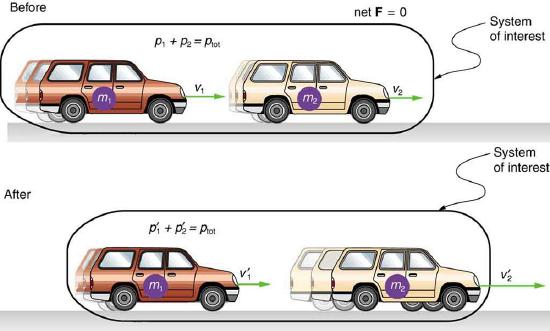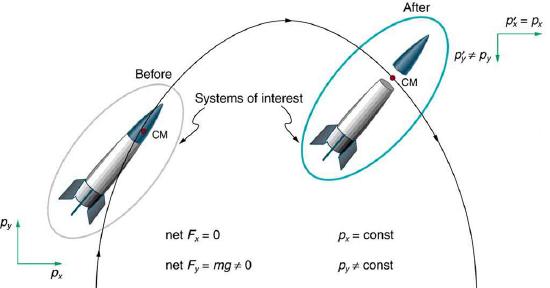4.4: Conservation of Momentum
( \newcommand{\kernel}{\mathrm{null}\,}\)
Learning Objectives
- Describe the principle of conservation of momentum.
- Explain conservation of momentum with examples.
In the previous sections in this chapter, changes in momentum for an object were considered in terms of impulse and force. But for certain conditions, the total momentum is conserved (stays constant). What are these conditions?
The answer to this question entails considering a sufficiently large system. It is always possible to find a larger system in which total momentum is constant, even if momentum changes for components of the system. If a football player runs into the goalpost in the end zone, there will be a force on him that causes him to bounce backward. However, the Earth also recoils —conserving momentum—because of the force applied to it through the goalpost. Because Earth is many orders of magnitude more massive than the player, its recoil is immeasurably small and can be neglected in any practical sense, but it is real nevertheless.
Consider what happens if the masses of two colliding objects are more similar (i.e, both objects are about the same mass) than the masses of a football player and Earth—for example, one car bumping into another, as shown in Figure \PageIndex{1}. Both cars are coasting in the same direction when the lead car (labeled m_{2}) is bumped by the trailing car (labeled m_{1}). The only unbalanced force on each car is the force of the collision. (Assume that the effects due to friction are negligible.) Car 1 slows down as a result of the collision, losing some momentum, while car 2 speeds up and gains some momentum. We shall now show that the total momentum of the two-car system remains constant.

Using the definition of impulse, the change in momentum of car 1 is given by
\Delta p_{1}=F_{1} \Delta t, \nonumber
where F_{1} is the force on car 1 due to car 2, and \Delta t is the time the force acts (the duration of the collision). Similarly, the change in momentum of car 2 is
\Delta p_{2}=F_{2} \Delta t, \nonumber
where F_{2} is the force on car 2 due to car 1, and, intuitively, the duration of the collision \Delta t is the same for both cars. We know from Newton’s third law that F_{2}=-F_{1}, and so
\Delta p_{2}=-F_{1} \Delta t=-\Delta p_{1}. \nonumber
Thus, the changes in momentum cancel out, and
\Delta p_{1}+\Delta p_{2}=0. \nonumber
Because the changes in momentum add to zero, the total momentum of the two-car system is constant. That is,
p_{1}+p_{2}=\text { constant }. \nonumber
Because of Newton's third law, when two objects in a system interact with each other, it does not change the total momentum of the system. In the absence of an external force (that is, force due to an object outside of the system, so that we can ignore the impulse due to the reaction force), the total momentum of the system is constant, or conserved. We call this the conservation of momentum principle.
We have noted that the motion in perpendicular directions—x, y, and —are independent. Momentum conservation follows this paradigm, and components of total momentum along each direction are conserved separately. For example, during projectile motion and where air resistance is negligible, momentum is conserved in the horizontal direction because horizontal forces are zero and momentum is unchanged. But along the vertical direction, the net vertical force is not zero and the momentum of the projectile is not conserved. (See Figure \PageIndex{2}.) However, if the momentum of the projectile-Earth system is considered in the vertical direction, we find that the total momentum is conserved.

The conservation of momentum principle can be applied to systems as different as a comet striking Earth and a gas containing huge numbers of atoms and molecules. Conservation of momentum is violated only when the net external force is not zero. But another larger system can always be considered in which momentum is conserved by simply including the source of the external force. For example, in the collision of two cars considered above, the two-car system conserves momentum while each one-car system does not.
MAKING CONNECTIONS: TAKE-HOME INVESTIGATION—DROP OF TENNIS BALL AND A BASKETBALL
Hold a tennis ball side by side and in contact with a basketball. Drop the balls together. (Be careful!) What happens? Explain your observations. Now hold the tennis ball above and in contact with the basketball. What happened? Explain your observations. What do you think will happen if the basketball ball is held above and in contact with the tennis ball?
MAKING CONNECTIONS: TAKE-HOME INVESTIGATION—TWO TENNIS BALLS IN A BALLISTIC TRAJECTORY
Tie two tennis balls together with a string about a foot long. Hold one ball and let the other hang down and throw it in a ballistic trajectory. Explain your observations. Now mark the center of the string with bright ink or attach a brightly colored sticker to it and throw again. What happened? Explain your observations.
Some aquatic animals such as jellyfish move around based on the principles of conservation of momentum. A jellyfish fills its umbrella section with water and then pushes the water out resulting in motion in the opposite direction to that of the jet of water. Squids propel themselves in a similar manner but, in contrast with jellyfish, are able to control the direction in which they move by aiming their nozzle forward or backward. Typical squids can move at speeds of 8 to 12 km/h.
The ballistocardiograph (BCG) was a diagnostic tool used in the second half of the 20th century to study the strength of the heart. About once a second, your heart beats, forcing blood into the aorta. A force in the opposite direction is exerted on the rest of your body (recall Newton’s third law). A ballistocardiograph is a device that can measure this reaction force. This measurement is done by using a sensor (resting on the person) or by using a moving table suspended from the ceiling. This technique can gather information on the strength of the heart beat and the volume of blood passing from the heart. However, the electrocardiogram (ECG or EKG) and the echocardiogram (cardiac ECHO or ECHO; a technique that uses ultrasound to see an image of the heart) are more widely used in the practice of cardiology.
MAKING CONNECTIONS: CONSERVATION OF MOMENTUM AND COLLISION
Conservation of momentum is quite useful in describing collisions. Momentum is crucial to our understanding of atomic and subatomic particles because much of what we know about these particles comes from collision experiments.
Section Summary
- The conservation of momentum principle says that the total momentum is conserved, or constant, in the absence of a net external force, as a direct consequence of Newton's third law.
- During projectile motion and where air resistance is negligible, momentum is conserved in the horizontal direction because horizontal forces are zero.
Glossary
- conservation of momentum principle
- when the net external force is zero, the total momentum of the system is conserved or constant


